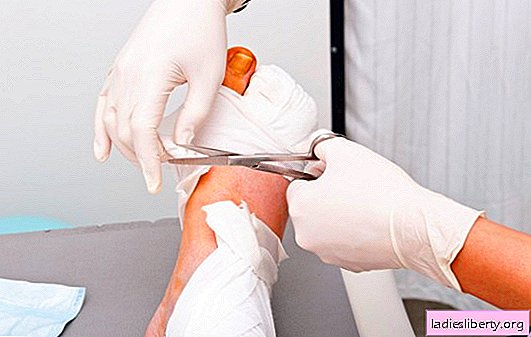
A trophic ulcer is a necrotic lesion of the tissues of the dermis. Most often manifested in older people (after 45 years), but no one is insured.
At first glance, it seems that a trophic ulcer is not dangerous. This is a false proposition: such pathologies are not terrible in themselves, but because of possible complications.
Almost always, ulcers occur on the legs or feet. What you need to know about trophic ulcer?
Causes of trophic ulcers on the leg
“From scratch” a similar symptom (and this is precisely a symptom) does not occur. The reasons are always pathological. Ulcers are caused by circulatory disorders in the lower extremities. Accordingly, the source of the problem may lie in:
• Diabetes mellitus. Diabetes mellitus is a serious and dangerous disease. Violations of the endocrine system lead to problems with blood circulation in the channel, changes in vascular permeability, and their fragility. As a result, a trophic ulcer is formed. In diabetes, the course of the ulcerative lesion is particularly aggressive. One of the main causes of trophic ulcers on the leg.
• Varicose veins. What is varicose veins - if not all, then most know, but few people imagine what this problem might turn into. Due to the development of blood clots, stenosis of the vessels of the lower extremities occurs, the tissues do not receive enough nutrition and oxygen and begin to die. The condition is no less dangerous than with diabetes, because it is fraught with loss of limb.
• Inguinal lymphadenitis. In this case, trophic ulcers occur due to possible thrombophlebitis.
• Hypertension. No matter how strange it may sound, trophic ulcers can develop as a complication of hypertension. In the course of a constant increase in pressure, a spasm of small vessels of the extremities occurs. As a result, the tissues again lack nutrition. As a rule, such lesions differ in small depth and do not affect the hypodermis (the lower layer of the skin and subcutaneous tissue).
• Diseases and injuries of the brain and spinal cord. These are the so-called neurotrophic ulcers.
• Ulcers may occur due to non-observance of simple hygiene rules. In this case, the origin of the pathology is infectious. The most common pathogen is Staphylococcus aureus. Before the symptom manifests itself in all its glory, furunculosis is observed. These skin lesions are called pyogenic.
• Erysipelas.
• Injuries can also provoke the development of trophic ulcers.
• Atherosclerosis of the vessels of the lower extremities. Appears, including due to smoking.
• Dermatitis (most often in children).
• Psoriasis
The possible causes of trophic ulcers on the leg are numerous. Understanding yourself what the root cause is is a waste of time. Without a thorough examination to determine the "root of evil" is impossible.
Trophic ulcer on the leg: the first symptoms and stages of pathology
Signs of trophic ulcers on the legs can be divided into two groups (although talking about symptoms is not entirely correct, since a trophic ulcer is a symptom in itself, this method is suitable to simplify the picture):
• Prior manifestations.
• The symptoms themselves.
The appearance of pathological symptoms of the second group is preceded by:
• Heaviness in the lower limbs. Appears due to lack of muscle nutrition.
• Feeling of numbness, numbness of the lower extremities.
• Slight aching pain in legs and / or feet.
All these manifestations eloquently support the problems with the lower extremities.
The trophic ulcer of the leg itself is accompanied by the following symptoms:
• Feeling of burning skin. It manifests itself due to circulatory disorders and damage to the nerve endings located in the epidermis (upper layer of the skin).
• Itching sensation in the affected area. Occur for the same reasons. The epidermis contains a huge number of nerve endings responsible for the itching sensation.
• In some cases, at night, “legs” in the legs. Cramps last from a few seconds to ten minutes.
• The skin tone changes. Instead of a healthy flesh-colored, the dermis becomes purple, reddish. It is important to differentiate the trophic ulcer on the leg, the first symptom of which is a discoloration and erysipelas.
• Dry skin. It is observed due to damage to the sebaceous glands.
• Soreness of the dermis when touched.
• The appearance of the ulcer itself. A trophic ulcer on the leg manifests itself most recently when the venous manifestations reach their maximum. The trophic ulcer looks like a round or oval spot-formation. Gradually, skin tissue erosion reaches such a stage that a crater forms. The extent of the process depends on the particular stage.
Stages of development of a trophic ulcer
Allocate 4 stages of the formation of trophic ulcers on the leg. At the first stage, only the epidermis is affected. The defeat is superficial. The second stage is characterized by damage to the middle layer of the skin with subcutaneous tissue. The third stage is characterized by a violation of the structures of the soft tissues. Finally, in the last stage, the ulcer is so deep that it reaches the bone.
Some distinguish the fifth stage, when scarring of the lesion occurs. This phase accompanies recovery.
Diagnosis of trophic ulcers and the source of the disease
In the early stages, diagnosis is difficult. The previous and very first symptoms of trophic ulcers on the leg accompany all vascular pathologies. Once the process begins, identifying it presents no difficulties. It is much more difficult to determine what caused the appearance, this is exactly the problem that the doctor has to solve.
Phlebological ulcers are practiced by phlebologists. If the pathology is observed against a background of diabetes, do not do without the help of an endocrinologist.
Diagnosis begins with a medical history when the doctor is interested in the patient's complaints. The most effective way to identify the primary source of the problem is instrumental research.
• Dopplerography of the vessels of the lower extremities. Needed to assess blood flow in the bloodstream. Usually there is a decrease in speed and a small volume of circulating blood. This is a direct indication of vascular problems.
• X-ray of the affected leg. It is necessary to accurately identify the stage of the disease.
Not without laboratory tests. The main one is a blood test for sugar and a specialized test. It reveals the diabetic nature of trophic ulcers.
Together, these methods help determine the cause of the problem. In the absence of objective data, daily monitoring of blood pressure, brain MRI / CT, and encephalography are prescribed.
Treatment of trophic ulcers on the leg
Treatment of a trophic ulcer on the leg is a serious task for the doctor. Most often resort to surgical treatment. Surgical treatment consists in draining the ulcer (removing purulent contents), removing necrotic tissue, and treating the wound with antiseptics.
There are other, more radical surgical methods, but they are the last resort. Drug treatment is widespread:
• Broad-spectrum antibiotics.
• Anti-inflammatory (NSAIDs).
• Antihistamines.
• Antiplatelet agents.
Together, these methods help to completely get rid of the ulcer. Questions about the appropriateness of surgical treatment, its type, names of drugs are decided on a strictly individual basis and only by the attending physician.
Trophic ulcer on the foot: prevention
Prevention of trophic ulcers on the leg is not particularly difficult. The following recommendations are given:
• For pain in the legs, swelling, stiffness, you should immediately contact a surgeon and / or phlebologist.
• It is important to observe personal hygiene.
• It is necessary to timely sanitize all possible sources of infection in the body.
Complications of a trophic ulcer
As already mentioned, an ulcer is not terrible in itself. Its complications are much worse. Among which:
• Gangrene.
• Sepsis (blood poisoning).
• Osteomyelitis (purulent lesion of the periosteum and bone).
• Death.
To avoid this, trophic ulcers should be treated on time.
Trophic ulcers are common. In most cases, they have a tendency to progression, so do not hesitate to visit a doctor.











